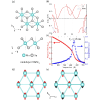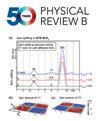单层 MnSe2 通过金属-半导体转变可能成为室温铁磁半导体
IF 3.7
2区 物理与天体物理
Q1 Physics and Astronomy
引用次数: 0
摘要
实现室温铁磁半导体仍然是自旋电子学的一项挑战。最近的实验获得了二维(2D)室温铁磁金属,如单层 MnSe2。本文提出了一种通过金属-半导体转变获得室温铁磁半导体的方法。通过密度泛函理论计算,在单层 MnSe2 中获得了室温铁磁半导体,拉伸应变为百分之几,其中金属-半导体转变发生在拉伸应变为 2.2% 的情况下。拉伸应变提高了费米级附近锰原子的 d 轨道和硒原子的 p 轨道的能量,使费米级设置在这些 p 轨道和 d 轨道的成键态和反键态的能隙中,并打开了一个较小的带隙。在异质结构 MnSe2/X(X = Al2Se3、GaSe、SiH 和 GaP)中也获得了室温铁磁半导体,异质结构界面的拉伸应变导致了金属-半导体转变。此外,在具有拉伸应变的单层 MnSe2 和基于 MnSe2 的异质结构中还获得了巨大的磁光克尔效应(MOKE)。我们的理论结果为从实验获得的二维室温铁磁金属通过金属-半导体转变获得室温磁性半导体铺平了道路。本文章由计算机程序翻译,如有差异,请以英文原文为准。

Possible room-temperature ferromagnetic semiconductor in monolayer MnSe2 through a metal-semiconductor transition
To realize room-temperature ferromagnetic semiconductors is still a challenge in spintronics. Recent experiments have obtained two-dimensional (2D) room-temperature ferromagnetic metals, such as monolayer . In this paper, we proposed a way to obtain room-temperature ferromagnetic semiconductors through metal-semiconductor transition. By the density-functional theory calculations, a room-temperature ferromagnetic semiconductor is obtained in monolayer with a few-percent tensile strain, where a metal-semiconductor transition occurs with 2.2% tensile strain. The tensile strains raise the energy of orbitals of Mn atoms and orbitals of Se atoms near the Fermi level, making the Fermi-level sets in the energy gap of bonding and antibonding states of these and orbitals, and opening a small band gap. The room-temperature ferromagnetic semiconductors are also obtained in the heterostructures /X (X = , GaSe, SiH, and GaP), where metal-semiconductor transition happens due to the tensile strains by interface of heterostructures. In addition, a large magneto-optical Kerr effect (MOKE) is obtained in monolayer with tensile strain and -based heterostructures. Our theoretical results pave a way to obtain room-temperature magnetic semiconductors from experimentally obtained 2D room-temperature ferromagnetic metals through metal-semiconductor transitions.
求助全文
通过发布文献求助,成功后即可免费获取论文全文。
去求助
来源期刊

Physical Review B
物理-物理:凝聚态物理
CiteScore
6.70
自引率
32.40%
发文量
0
审稿时长
3.0 months
期刊介绍:
Physical Review B (PRB) is the world’s largest dedicated physics journal, publishing approximately 100 new, high-quality papers each week. The most highly cited journal in condensed matter physics, PRB provides outstanding depth and breadth of coverage, combined with unrivaled context and background for ongoing research by scientists worldwide.
PRB covers the full range of condensed matter, materials physics, and related subfields, including:
-Structure and phase transitions
-Ferroelectrics and multiferroics
-Disordered systems and alloys
-Magnetism
-Superconductivity
-Electronic structure, photonics, and metamaterials
-Semiconductors and mesoscopic systems
-Surfaces, nanoscience, and two-dimensional materials
-Topological states of matter
 求助内容:
求助内容: 应助结果提醒方式:
应助结果提醒方式:


